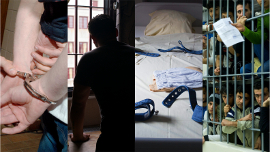In the course of the visit, particular attention was paid to the treatment of persons detained by the police and the conditions of detention in police arrest houses. The treatment and regime of prisoners, including life-sentenced prisoners, were also examined. In addition, a targeted visit was carried out to Vilnius Republican Psychiatric Hospital focusing on the application of means of restraint.
The vast majority of detained persons interviewed by the CPT’s delegation in the course of the visit indicated that they had been treated correctly whilst in police custody. However, the delegation did receive a few allegations, including from juveniles, of excessive use of force (such as kicks and punches) by the police at the time of apprehension, after the person concerned had been brought under control. The Committee encourages the Lithuanian authorities to pursue their efforts to ensure that police officers use no more force than is strictly necessary when effecting an apprehension. Further, recommendations are made aimed at strengthening the fundamental safeguards against police ill-treatment.
As regards conditions of detention in the police arrest houses visited, the report highlights various shortcomings (e.g. limited access to natural light; non-partitioned in-cell toilets; filthy mattresses and blankets; etc.). In their response, the Lithuanian authorities refer to the ongoing and planned refurbishment of several police detention facilities as well as to plans to construct new facilities.
In relation to the prisons visited, the CPT’s delegation received a number of consistent allegations of deliberate physical ill-treatment and of excessive use of force (consisting mostly of punches, kicks and truncheon blows) by certain prison officers at Alytus Prison. In some cases, the delegation gathered medical evidence which were consistent with allegations made. Some allegations of inappropriate use of truncheons were also received at Šiauliai Prison. As regards investigations into complaints of ill-treatment by prison staff, the CPT expresses serious misgivings about their effectiveness. Further, the Committee notes with great concern that there was a high level of inter-prisoner violence at Alytus Prison, partly attributable to the fact that only a small number of prison officers was present in prisoner accommodation areas during the day and even fewer at night or at weekends.
The report highlights a number of other issues of concern, such as poor material conditions of detention and serious levels of overcrowding in most of the establishments visited, an impoverished regime for remand prisoners, and insufficient health-care staff resources at Alytus and Lukiškės Prisons. Particular attention is paid to the situation of persons sentenced to life imprisonment. The CPT stresses once again that there can be no justification for the systematic segregation of life-sentenced prisoners from other prisoners and urges the authorities to institute a process for integrating this category of prisoner into the general prison population.
In their response, the Lithuanian authorities refer to training programmes offered to prison officers on the use of physical force and special means. Further, information is provided on the steps being taken to combat prison overcrowding, including by placing emphasis on non-custodial measures for remand prisoners (such as electronic surveillance) and developing alternatives to imprisonment. Reference is also made to measures taken or envisaged to improve material conditions in the prisons visited as well as to plans to construct new prison establishments in Vilnius and Šiauliai.
The visit report and government response are available on the Committee’s website: http://www.cpt.coe.int



